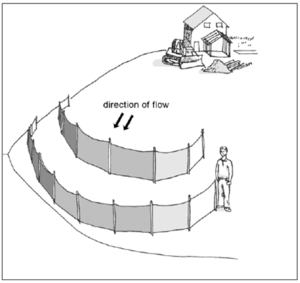
Sediment control practices - Perimeter controls for disturbed areas
This page is under development. We anticipate populating it in autumn, 2016.
Contents
Perimeter Controls for Disturbed Areas
Definition
Perimeter controls for disturbed areas are temporary sediment barriers that intercept and remove soil and debris from sheet flow runoff on construction sites. Removal mechanisms include ponding the runoff to allow for settling, and physically filtering sediment as it passes through a sediment barrier (e.g., silt fence, rock/soil berm, gravel bags, fiber log, etc.). Some designs (e.g., berms, ditches) use perimeter controls to collect and convey sheet flow to larger treatment areas, such as sediment traps, where sediment removal can occur through multiple processes.
Purpose and Function
Perimeter controls intercept sheet flow from slopes and remove sediment and other contaminants through ponding, settling, and physical filtration, effectively preventing contaminants from leaving the site and entering surface waters. Concentrated flows within the site typically require treatment via source controls, sediment traps, settling ponds, or other methods prior to reaching the site perimeter. Ditch check dams are also used for small concentrated flows.
Although silt fences are one of the most commonly used methods of perimeter control, other perimeter control BMPs are available that can be equally or more effective depending on site conditions. Typical perimeter control methods include:
- Silt fence (super duty, machine sliced, hand installed, preassembled)
- Ditch checks (fiber rolls/biorolls, filter/rock/compost log, etc.)
- Sediment traps or berms (rock, soil, compost, etc.)
- Perimeter control ditches
- Other (sand bags, rock logs, snow berm, etc.)
In most applications, treatment occurs at or along the perimeter control device, e.g., silt fence, rock berm, and fiber log. Other applications may involve the use of perimeter control berms or ditches to direct sheet flows to a treatment area, such as a sediment trap, sediment basin, or other BMP. Perimeter controls are generally recognized as the last line of defense in a system of erosion prevention and sediment control, and are usually placed near the downgradient borders of disturbed areas and soil stockpiles. They are also used to separate work zones from adjacent waterbodies.
Applicability
Perimeter controls are universally used to ensure that sediment and other contaminants are contained on the construction site. The wide variety of perimeter control materials, configurations, and uses make them a standard practice on nearly all construction sites where clearing, grading, excavation, or fill activities occur. The location and type of perimeter control BMPs, along with other sediment control BMPs required by the Permit, must be identified in the site’s Stormwater Pollution Prevention Plan.
Site Applicability
Perimeter controls are useful on nearly every site as part of a system of BMPs designed to prevent erosion and control sediment transport to offsite areas. The selection, installation, operation, and maintenance of a particular perimeter control or group of controls is based on site considerations: slopes, soils, site size, proximity of waterbodies, and other factors. In general, super duty silt fence and rock berms provide the most protection, and are typically indicated below steeper, longer slopes under construction during the wet season. Shorter, flatter slopes under construction during dry or frozen periods can be protected with lighter duty controls (e.g., fiber rolls). The use of silt fences as a sediment barrier is not recommended in areas of concentrated flow, such as ditches. In these cases, soil berms, silt dikes, straw wattles, excelsior logs, rock check dams, or other BMPs suitable for concentrated flow should be used.
Permit Applicability
Section IV.C.2 of the 2013 MPCA Construction Stormwater General Permit states that “sediment control practices must be established on all downgradient perimeters and be located upgradient of any buffer zones” (for information on buffer zones required for temporary BMPs during construction, see Part IV.C.9; for buffer zones required as permanent BMPs, see Appendix A, Part C.3). “The perimeter sediment control practice must be in place before any upgradient land‐disturbing activities begin. These practices shall remain in place until Final Stabilization has been established”.
In addition, the permit notes that “(a) floating silt curtain placed in the water is not a sediment control BMP to satisfy perimeter control requirements in (Part IV.C.2) except when working on a shoreline and below the waterline. In those cases, a floating silt curtain can be used as a perimeter control practice if the floating silt curtain is installed as close to shore as possible. Immediately after the short term construction activity (e.g., installation of rip rap along the shoreline) in that area is complete, an upland perimeter control practice must be installed if exposed soils still drain to the surface water.”
Section IV.C.3 is also applicable to perimeter control BMPs, and states: Permittee(s) “shall re-install all sediment control practices that have been adjusted or removed to accommodate short‐term activities such as clearing or grubbing, or passage of vehicles, immediately after the short‐term activity has been completed. The Permittee(s) shall complete any short‐term activity that requires removal of sediment control practices as quickly as possible. The Permittee(s) must re‐install sediment control practices before the next precipitation event even if the short‐term activity is not complete.”
Effectiveness
Perimeter control BMPs are effective at preventing offsite sediment discharges in sheet flow when used with an appropriate upgradient system of erosion prevention and sediment control BMPs (e.g., upslope diversions, timely seeding and mulching) that minimize both the area and time of exposed soil. In some
